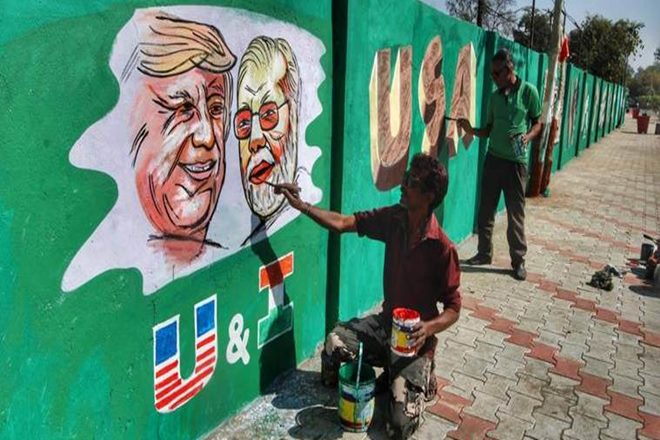By Brig NK Bhatia
President Trump’s forthcoming India visit on 24 and 25 February will provide an opportunity for India to resurrect one of its most crucial global infrastructure projects launched in cooperation with Iran which has strategic implications for India’s access to Afghanistan and Central Asia. Chabahar Port lies on the Southeastern periphery of Iran in the Sistan – Baluchistan region of Iran abutting the Gulf of Oman in proximity to Pakistan and its port of Gwader being developed with Chinese assistance as part of broader China Pakistan Economic Corridor (CPEC).
As is well known, India’s humanitarian assistance to Afghanistan focusses on the continued development assistance for the people of Afghanistan who consider India as one of the most trusted friends. India has been unable to contribute to the extent it wants as Pakistan continues to play spoiler in denying India access through land route passing through its territory.
As an alternative, India’s aid to Afghanistan and its bilateral trade relationship with Afghanistan hinges on uninterrupted operationalising of the Chabahar port. However global geo politics and long-running hostility between Iran and the USA have resulted in massive delays in India’s efforts to finish the projects associated with the development of Chabahar.
Chabahar port, in the works for close to two decades took off in right earnest only in 2016 after India, Iran and Afghanistan signed a Trilateral Transit & Trade Agreement to develop Chabahar primarily with an aim to boost India-Afghanistan trade, post negotiations and conclusion of The Joint Comprehensive Plan of Action (JCPOA) in October 2015 which was implemented effective January 2016. Simultaneously India also signed a bilateral agreement with Iran to refurbish a berth at Shahid BeheshtiTerminal and extend a berth to 630 meters for handling large containers.
However US re-imposition of economic sanctions in 2018 only made things difficult for India to proceed with the development of Chabahar, notwithstanding the US exemptions granted in November 2018 for development of Chabahar, from sanctions imposed on Iran because of Afghanistan’s development and economic growth was considered important for the success of the United States’ South Asia strategy.
The project also faced delays as the European and Chinese suppliers who had bagged contracts worth the US $ 85 million to supply equipment for the port, have been reluctant to deliver the equipment, fearing an adverse impact on their business with the US. Another reason for the delay has been the slow pace of works relating to rail connectivity to Afghanistan through Iran.
There is no doubt that Indian commitment to continue the works need a vigorous impetus. The aid for the strategically-important Chabahar Port, which did not have any budgetary allocation in the revised estimates of 2019-20, has gone up to Rs100 crore for the next fiscal year (2020-21), as announced in the latest annual budget, showing India’s commitment to strive for early completion of works in Chabahar. But the same needs to be scaled up for worthwhile progress on the project.
So far the development of Chahbahar has been piecemeal and trade limited. The first Indian shipment of 110,000 tonnes bound for Afghanistan arrived in Chabahar in November 2017. In the reverse direction Afghan President, Ashraf Ghani, flagged off the first Afghan cargo bound for the port comprising 570 tons of goods in February 2019. Thereafter four more consignments of Afghan goods have passed through Chabahar. Overall the unstable geopolitical situation in the region and ever-looming fear of hostilities continues to impact the development of the port. Consequently, Afghanistan seems to bear the consequences.
The US will need to be convinced not only about the importance of Chabahar for India but also its relevance to the USA in the backdrop of changed realities in Afghanistan and US eagerness to pull back completely from the region over the next three years.
With the Taliban likely to be a dominant player post US withdrawal, Pakistan’s hold over any access to Afghanistan for any foreign aid and trade is likely to be complete, putting Afghanistan at great risk. Chabahar would significantly reduce Pakistan’s hold over Afghanistan since it provides for an alternate sea route for all trade to and from Afghanistan by bypassing Pakistan.
The US would need to withdraw its heavy military and other equipment from Afghanistan and could make use of Chabahar for the same. It may be worthwhile to remind the US about Pakistan’s blockade of US military supplies through its ports and land routes to Afghanistan in not so distant past.
India would also need to emphasise to the US that the Trilateral Transit & Trade Agreement of 2016 between India, Afghanistan and Iran makes all three countries an equal stakeholder in the development of Chabahar port. It would be in the interest of the US to see the completion of the project and give landlocked Afghanistan the freedom to access sea routes without fear of blockages and blackmail.
(Author is an Indian Army Veteran. Views expressed are personal).


